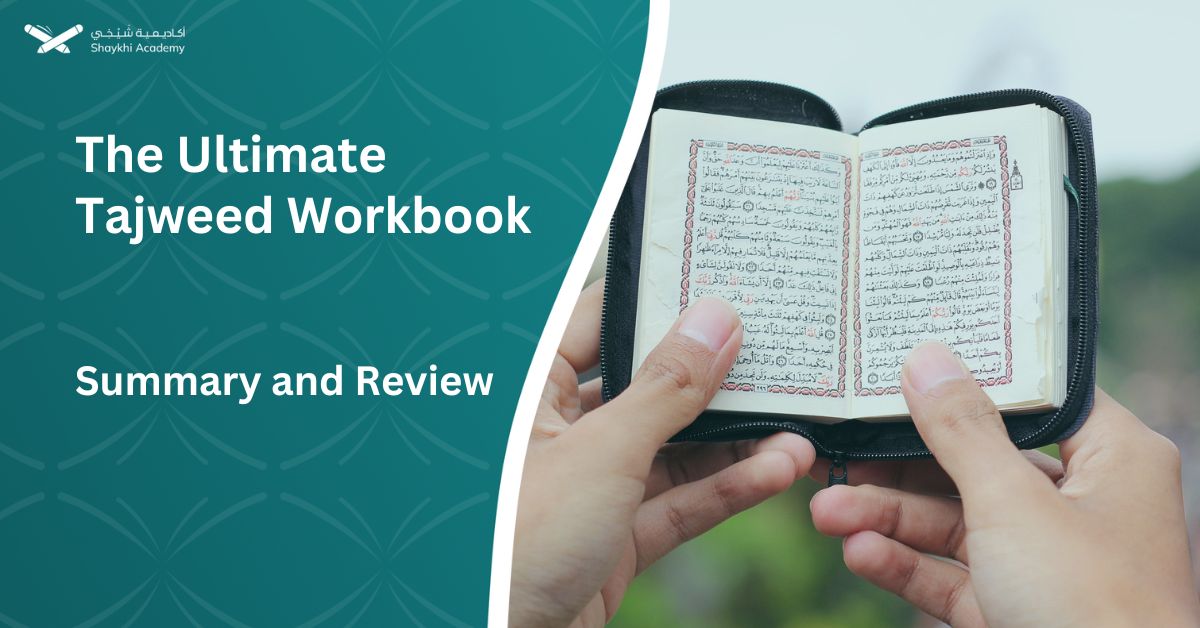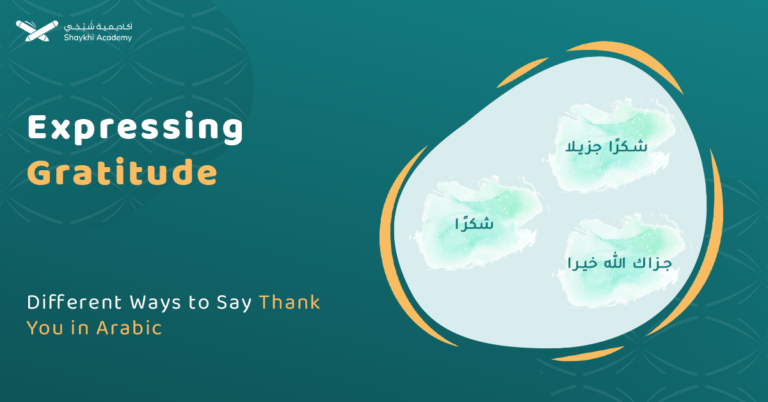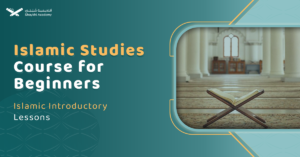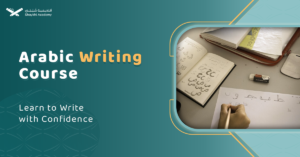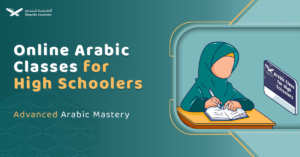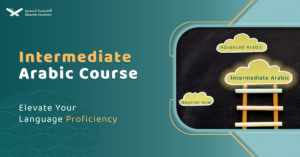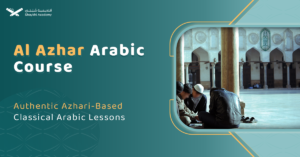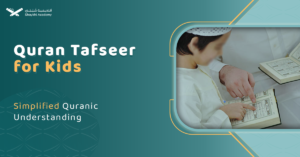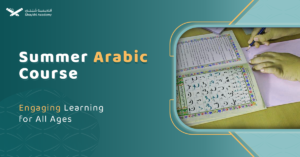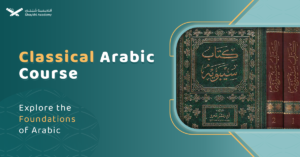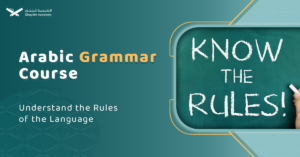The Ultimate Tajweed Workbook is a comprehensive guide to mastering Quranic recitation, covering essential topics like pronunciation rules and stopping points. Through detailed explanations and exercises, learners enhance their fluency and accuracy in recitation, ensuring a beautiful rendition of the Quran.
Tajweed books are crucial for mastering Quranic recitation, providing detailed rules and principles for correct pronunciation. These resources include explanations, diagrams, examples, and exercises to aid learners.
The Ultimate Tajweed Workbook is a standout guide, covering essential aspects, which has lead the prestigious tutors of the Tajweed course at Shaykhi Academy to use it as part of the curriculum in some cases.
With practical exercises and assessments, this workbook ensures learners can confidently apply Tajweed rules, making it an invaluable tool in Quranic recitation classes such as Shaykhi Academy’s.
The Ultimate Tajweed Workbook:
The Ultimate Tajweed Workbook is a comprehensive guide designed to help learners master the rules of Tajweed, the proper pronunciation and recitation of the Quran.
Both adults and kids can benefit greatly from studying this book in their pursuit of the Tajweed art, which inspired the tutors of Shaykhi Academy’s Tajweed courses for kids to incorporate it in the classes.
What are the Chapters of The Ultimate Tajweed Workbook?
Here’s a detailed description of each chapter:
1- Madd Letters:
This chapter delves into the concept of elongation in Quranic recitation. Madd letters, which include Alif, Waw, and Ya, are crucial for extending the pronunciation of a vowel sound.
The chapter explains different types of Madd such as Madd Asli (natural elongation) and Madd Far’i (secondary elongation), detailing their rules and conditions, such as the presence of Hamzah or Sukoon.
Practical examples and exercises help learners master the correct lengthening of these sounds, enhancing the fluency and melody of their recitation.
2- Leen Letters:
Leen letters, specifically Waw and Ya when preceded by a Fatha, create a soft and light sound. This chapter explains the pronunciation of these letters in different contexts, emphasizing their smooth transition in speech.
Detailed rules cover the instances where Leen letters appear and the appropriate amount of softness to apply. Exercises in this chapter aim to help learners practice and recognize Leen sounds in various Quranic verses.
3- The 5 Main Makharij:
The five main Makharij (articulation points) are fundamental for proper Arabic pronunciation. This chapter breaks down these primary points, which include the throat, tongue, lips, nasal cavity, and the oral cavity.
Each section provides in-depth explanations and diagrams, showing where and how each letter is produced. Through guided practice, learners develop a keen awareness of the precise articulation required for each letter, which is essential for clear and accurate recitation.
4- The Specific Makharij:
Expanding on the main Makharij, this chapter delves into the specific articulation points for each Arabic letter. It covers the nuances of pronunciation, such as the difference between letters that may seem similar but have distinct articulation points.
Detailed instructions and visual aids help learners fine-tune their pronunciation, ensuring each letter is articulated correctly according to classical Tajweed principles.
5- Ghunna:
Ghunna refers to the nasalization of certain sounds, primarily occurring with Noon and Meem. This chapter explains the characteristics of Ghunna, its duration, and the rules governing its application.
Through practical examples and exercises, learners practice incorporating Ghunna into their recitation, achieving a smooth and melodious sound that enhances the overall beauty of the Quran.
6- Qalqalah:
This chapter focuses on the concept of Qalqalah, a bouncing sound that occurs with specific letters (Qaf, Ta, Ba, Jim, and Dal) when they are in a state of Sukoon (rest).
The chapter explains the rules for applying Qalqalah, differentiating between minor, medium, and major Qalqalah.
Exercises help learners practice producing the distinctive bouncing sound without distorting the surrounding letters, ensuring clear and emphatic recitation.
7- Heavy Letters:
Heavy letters, or Mufakham letters, require a full and deep pronunciation. This chapter identifies these letters (such as Sad, Dad, Ta, and Zha) and provides rules for their correct pronunciation.
The distinction between heavy and light letters is emphasized, with exercises designed to help learners practice the correct tongue position and vocal resonance needed to produce the heavy sound without merging it with light letters.
8- Ra Rules:
The pronunciation of the letter Ra varies depending on its context. This chapter outlines the rules for when Ra should be pronounced heavy (full mouth) or light (empty mouth).
Factors such as the presence of specific vowels, Sukoon, or surrounding letters influence its pronunciation.
Detailed guidelines and practical exercises enable learners to master these variations, ensuring the correct application in different Quranic contexts.
9- The Lam Rules:
The letter Lam also has specific pronunciation rules, particularly in the context of the definite article “Al.”
This chapter explains when Lam should be pronounced heavy or light based on the following letter.
Detailed rules and examples provide clarity on these variations, and exercises help learners practice the correct articulation to maintain the intended meaning and fluency in recitation.
10- Noon Sakinah and Tanween Rules:
This chapter covers the rules for Noon Sakinah (static Noon) and Tanween (double vowel sounds).
It explains the various outcomes such as Izhar (clear pronunciation), Idgham (merging), Iqlab (conversion), and Ikhfa (hiding).
Each rule is detailed with examples and exercises, helping learners understand and apply the correct pronunciation in different scenarios, ensuring smooth and accurate recitation.
11- Meem Sakinah Rules:
Similar to Noon Sakinah, Meem Sakinah (static Meem) has specific rules that affect its pronunciation.
This chapter covers the rules of Izhar Shafawi (clear labial pronunciation), Ikhfa Shafawi (hiding at the lips), and Idgham Shafawi (labial merging).
Detailed explanations and practical exercises guide learners in mastering these rules, ensuring proper articulation and fluency.
12- The Sun Letters:
Sun letters cause the definite article “Al” to assimilate, affecting the pronunciation of words. This chapter identifies these letters and explains the assimilation process, providing rules and examples.
Exercises help learners practice recognizing and applying the assimilation, ensuring smooth transitions and correct pronunciation in recitation.
13- The Moon Letters:
In contrast to Sun letters, Moon letters do not cause assimilation of the definite article “Al.”
This chapter identifies the Moon letters and explains how to pronounce them with the definite article intact.
Detailed rules and examples help learners practice maintaining the distinct pronunciation, ensuring clarity and proper recitation.
14- Waqf:
Waqf refers to the rules of stopping in Quranic recitation. This chapter explains the different types of Waqf, such as mandatory, permissible, and forbidden stops.
It provides guidelines on where to pause to maintain the meaning and flow of the verses. Practical exercises help learners develop the skill of pausing correctly, enhancing their recitation’s coherence and comprehension.
15- Waqf Signs:
Building on the previous chapter, this section explains the various Waqf signs found in the Quran, such as small letters or symbols indicating different types of stops.
Each sign’s meaning and application are detailed, providing learners with the knowledge to interpret these signs accurately. Exercises help learners familiarize themselves with these signs and practice their application in recitation.
16- Sakt:
Sakt involves a brief pause without taking a breath, applied in specific places in the Quran. This chapter explains the rules for Sakt, detailing where and how to apply this pause.
Practical examples and exercises help learners practice the Sakt, ensuring they can incorporate it seamlessly into their recitation, maintaining the intended meaning and flow.
17- Madd:
The final chapter revisits the concept of Madd, providing a comprehensive overview of the different types of elongation.
It covers natural Madd (Madd Asli), and various forms of secondary Madd (Madd Far’i) such as Madd Munfasil, Madd Muttasil, Madd Lazim, and others.
Detailed rules, examples, and exercises help learners understand and apply the correct elongation, enhancing the melodic quality and precision of their recitation.
Best Alternative: Al-Menhaj
Al-Menhaj is the Best Learn Quran Reading book for beginners! Learn to read Quran Book. Al-Menhaj Book is categorized as a Learn to Read Quran book for beginners and is considered as the first stage in your journey to learn to read Quran. You can buy this book and learn it self-study or you can learn it with one of our qualified online Quran teachers.
Unlock the beauty of Quranic recitation with our comprehensive online Tajweed course!
Whether you’re a beginner or looking to refine your skills, our expert Tajweed course at Shaykhi Academy will guide you through every step.
Some tutors will consult the acclaimed “Ultimate Tajweed Workbook,” a must-have resource that covers essential and advanced Tajweed rules with practical exercises.
Why Choose Shaykhi Academy?
- Connect with highly qualified native tutors.
- Flexible scheduling to suit your busy lifestyle.
- Affordable classes tailored for all levels.
- Accessible from anywhere around the globe.
Discover Our Range of Courses:
- Arabic Noorani Qaida: Lay a solid foundation for Quranic studies.
- Online Quran Classes for Kids: Engaging lessons for lifelong learning.
- Tajweed Rules for Kids: Learn to recite with confidence.
- Quran Hifz for Kids: Step-by-step guidance to memorize the Quran.
- Quran for Adults: Introduce yourself to Quran reading and Tajweed rules.
- Online Arabic Courses: Master the language of the Quran.
- Islamic Studies: A wide range of topics related to Islam, including theology, law, Quranic studies, Hadith.
Don’t Miss Out on Your Chance to Excel!
Enroll now to deepen your understanding, enhance your recitation, and connect more profoundly with the Quran. Start your journey today and master the art of Tajweed!

Conclusion:
The Ultimate Tajweed Workbook is a thorough guide aimed at helping learners master the intricacies of Tajweed, the correct pronunciation and recitation of the Quran. Covering essential topics like Madd and Leen Letters, Makharij, Ghunna, Qalqalah, and rules for letters like Ra and Lam.
It provides detailed explanations, examples, and exercises to enhance fluency and accuracy in recitation. With chapters on stopping (Waqf), Waqf signs, Sakt, and a comprehensive review of Madd, the workbook equips learners with the necessary skills to recite the Quran beautifully and correctly.
By incorporating practical exercises and assessments, this workbook ensures that learners can confidently apply Tajweed rules in their recitation, making it an invaluable tool for achieving proficiency in Quranic recitation.
